-
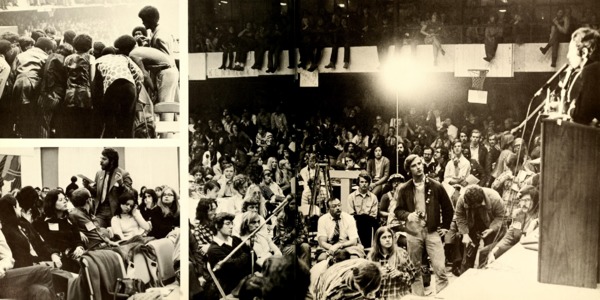
A two-page spread in the Loyolan yearbook of 1972 shows three photos from the three-day Conference for New Voters held at Loyola, run by the National Youth Causus to increase youth influence on the 1972 election. The top left photo shows a group of attendees huddled close and speaking, with one attendee standing higher than the others. The lower left photo shows a speaker walking between rows of seated attendees, gesturing with one hand. The right photo shows a speaker at a podium and a packed house, including an attendee with a camera and a balcony where attendees sit, dangling legs down over the side.
The caption reads:
"The tone was anti-Nixon, pro-peace, pro-economic stability, and pro-racial equality.
Representatives of political minorities-- the blacks, Chicanos and Latinos, and "the ladies"-- in some cases struggled to be heard."
Image 1: Entire 2-page collage.
Image 2: Detail shot of right page, p.103
-
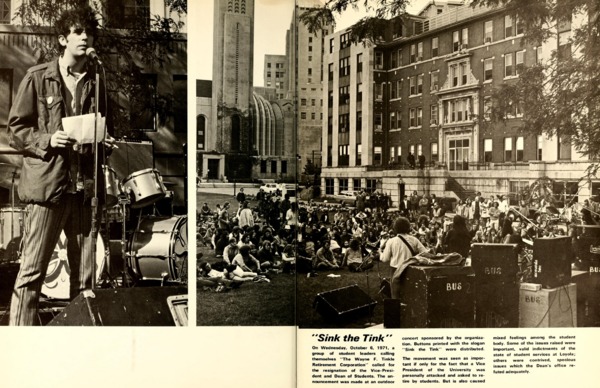
A double-page spread in the 1972 Loyolan yearbook displays two images of an outdoor concert where The Wayne F. Tinkle Retirement Corporation, a student group with the slogan "Sink the Tink," called for the resignation of Loyola vice president Mr. Tinkle. The caption reads:
"On Wednesday, October 6, 1971, a group of student leaders calling themselves "The Wayne F. Tinkle Retirement Corporation" called for the resignation of the Vice-President and Dean of Students. The announcement was made at an outdoor concert sponsored by the organization. Buttons printed with the slogan "Sink the Tink" were distributed.
The movement was seen as important if only for the fact that a Vice President of the University was personally asked to retire by students. But is also caused mixed feelings among the student body. Some of the issues raised were important, valid indictments of the state of student services at Loyola; others were contrived, specious issues which the Dean's office refuted adequately."
-

Item 1:
This article by Ray Sanders covers the Student Services effort to shovel the streets around the Loyola campus in the winter of 1977-78.
"Because of the recent pile up of snow, Student Services has masterminded a reclamation of the streets surrounding the Loyola campus called 'Operation Dig Out.'
Mr. Keith Patrick, director of activities, enthusiastically took the job of coordinator and quickly got everything started, and almost finished, during the week of Feb. 6.
Monday night this idea came into being with the help of many people and organizations by 2:30 the next day. 'Operation Dig Out' had begun. To get all the material needed for the job, Mr. Patrick talked to Neil Hartigan, committeeman for the 49th ward. Mr. Hartigan conferred with the city who swiftly agreed to supply all the equipment needed.
The process of removing the snow was fairly easy once everything got started. At 2:30, three tow trucks, two earth movers, and at least thirty shovel carrying students made their presence known on Loyola Avenue.
First they blocked off both sides of the street and the tow trucks began towing a few cars into the Mertz parking lot. (If your car has disappeared look in the Mertz parking lot.) But most people as soon as they saw the tow trucks moved their cars with a little help from the ever present students. Then the earth movers came along and cleared the snow from the streets.
What did the residents who live around the Loyola campus have to say? Mr. Patrick was told by many people, "This was one of the most positive things Loyola has ever done for us."
In all there have been three dig outs put on during the past week. The first one was worked on by the students, the second one was sponsored by Alpha Delta Gamma, and the third by the TKE's and Gonzaga.
Everyone concerned with the project was very pleased. As Mr. Patrick said, "This is an example of what the students and the university can do with a little bit of cooperation." When asked how everything went, Mr. Patrick put it this way:
'An absolute success.'"
Item 2:
Detail of the top three photos and title of the article, showing students outside with shovels, digging out cars.
Item 3:
Detail from the bottom photo in the article, showing students shoveling along a sidewalk in front of a row of houses.
-
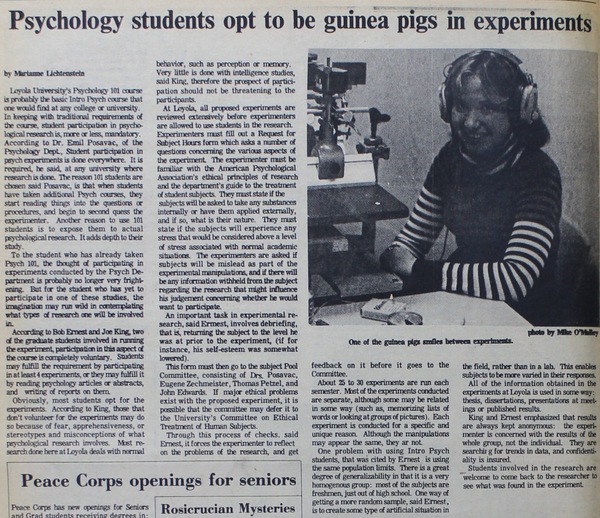
This article by Marianne Lichtenstein covers the voluntary participation of Psychology 101 students in psychological research at Loyola. Topics include how these experiments get approved, the debriefing, and the University's Committee on Ethical Treatment of Human Subjects. 25-30 experiments were run each semester, and results were kept anonymous. Students could also learn about the results afterwards. The interviewees also noted that the mostly-freshman college student pool was a limited test population, and there were probably other ways to get more diverse populations.
-
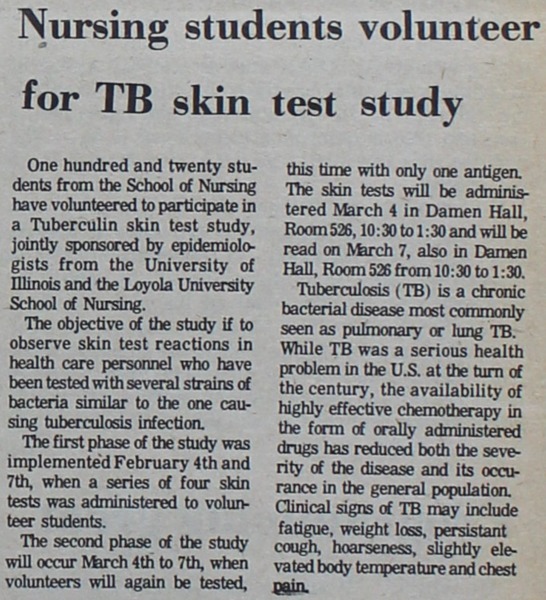
This article covers 120 nursing students' participation in a tuberculosis skin test.
"One hundred and twenty students from the School of Nursing have volunteered to participate in a Tuberculin skin test study, jointly sponsored by epidemiologists from the University of Illinois and the Loyola University School of Nursing.
The objective of the study [is] to observe skin test reactions in health care personnel who have been tested with several strains of bacteria similar to the one causing tuberculosis infection.
The first phase of the study was implemented February 4th and 7th, when a series of four skin tests was administered to volunteer students.
The second phase of the study will occur March 4th to 7th, when volunteers will again be tested, this time with only one antigen. The skin tests will be administered March 4 in Damen Hall, Room 526, 10:30 to 1:30 an will be read on March 7, also in Damen Hall, Room 526 from 10:30 to 1:30.
Tuberculosis (TB) is a chronic bacterial disease most commonl seen as pulmonary or lung TB. While TB was a serious health problem in the U.S. at the turn of the century, the availability of highly effective chemotherapy in the form of orally administered drugs has reduced both the severity of the disease and its occurance in the general population. Clinical signs of TB may include fatigue, weight loss, persistant cough, hoarseness, slightly elevated body temperature and chest pain."
-
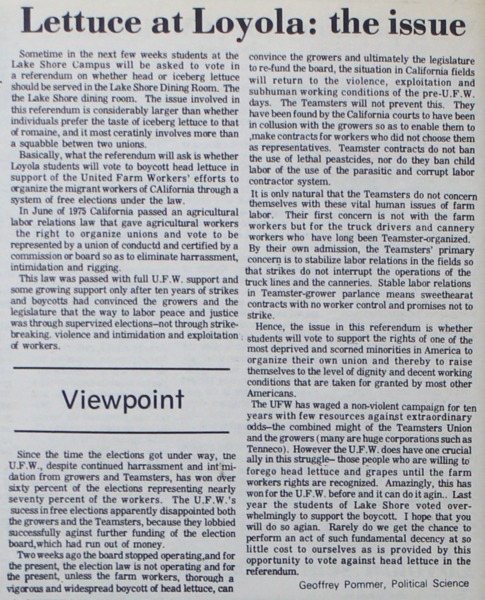
In this article, "Geoffrey Pommer, Political Science" explains the details of the upcoming Loyola referendum on whether to support the United Farm Workers by banning head lettuce. This would deprive the growers of revenue, thus supporting the UFW's nonviolent campaign for better conditions.
-
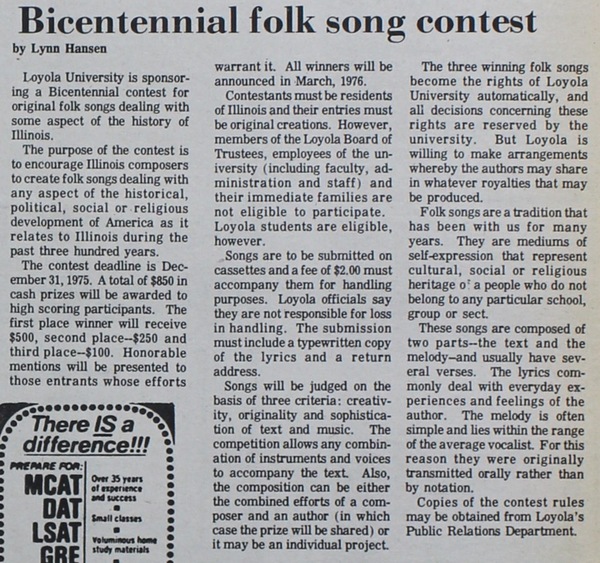
This article by Lynn Hansen describes a contest sponsored by Loyola for "original folk songs dealing with some aspect of the history of Illinois" to commemorate the bicentennial of America's independence from Britain. The contest deadline was December 31, 1975, with cash prizes for winning submissions to be announced in March, 1976. Contestants had to be Illinois residents, and students could enter, but not any Loyola employees or their families. A $2.00 handling fee was charged. Loyola would receive the rights to the three winning songs, but would make arrangements for sharing royalties.
The author describes folk songs: "Folks songs are a tradition that has been with us for many years. They are mediums of self-expression that represent cultural, social or religious heritage of a people who do not belong to any particular school, group, or sect."
-
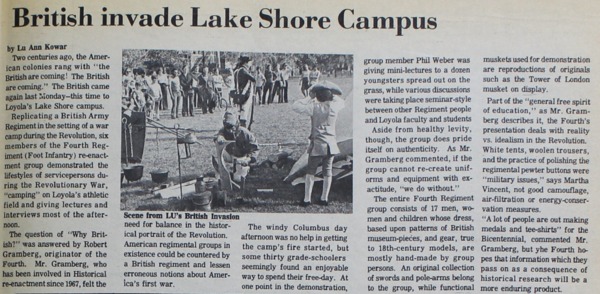
Item 1:
This article by Lu Ann Kowar covers a Revolutionary War re-enactment held at the Loyola Lake Shore Campus athletic field to commemorate the war by holding demonstrations, lectures, and interviews. Loyola students and faculty attended, as did younger students.
The reenacting group was clled the Fourth Regiment (Foot Infantry) and was made up of 17 members in handmade historic uniform with replica weapons and tools. They aimed to dispel assumptions about what the war was really like.
Item 2:
This detail includes the photo featured in the article, showing reenacters in a field using tools while a crowd watches.
-
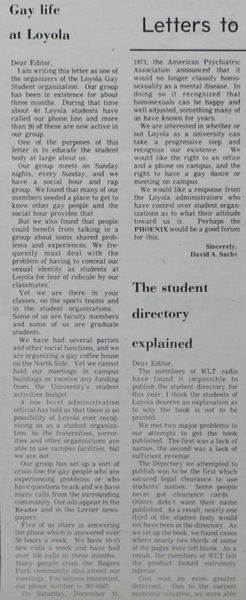
Item 1: This letter to the editor was sent by David A. Sachs, one of the organizers of the Loyola Gay Student Organization, which had been in existence for about three months and had about 20 active members.
The group met every week to socialize, meet other gay people, and discuss shared problems and experiences. Gay people at Loyola reported fearing ridicule from their peers, and the administration refused to recognize them as an organization, barring them from meeting on campus or receiving any funding. Sachs points out that "On Saturday, December 15, 1973, the American Psychiatric Association announced that it would no longer classify homosexuality as a mental disease. In doing so it recognized that homosexuals can be happy and well adjusted, something many of us have known for years.
We are interested in whether or not Loyola as a university can take a progressive step and recognize our existence. We would like the right to an office and a phone on campus, and the right to have a gay dance or meeting on campus."
Item 2: Detail of the second, third, and fourth paragraph of the letter, outlining the group's activities and concerns.
-

Item 1: This column by Jim Mueller describes a student movement called "Sink the Tink," which announced plans at an outdoor concert to call for the resignation of Vice-President and Dean of Student Wayne F. Tinkle. The students listed 5 main grievances, including the firing of Jim Robinson, former director of the Student Activities Office, and Bill Svrluga, former head of the Student Housing Office. They also demanded a search committee to replace these two administrators with student representatives. Another grievance was the heroin usage problem at Loyola. Students felt that Mr. Tinkle was more concerned with alcohol use than with the heroin problem, and that he had been "boorish" in attempting to act in loco parentis of students by attempting to remove Playboy from sale at a campus store. Finally, they pointed to the complete lack of doctors at the Student Health Service and the lack of improvement from the year before. The author comments that since nearly all student groups signed on to the "Sink the Tink" letter, it showed that "many of the student leaders at Loyola have lost all respect and lines of communication with the Dean of Students. If the new organization can take its case to the main student body and win, the Office of Student Personnel will become, in effect, obsolete. The failure or success of any such office relies on the trust and open lines of communication which it maintains with the student body."
Item 2: Detail of first two paragraphs of the article describing the group's announcement and first two grievances.
-

Item 1: This article by Eileen Gentile discuses Campus Ministry's Assisi Center, which aimed "to promote human and Christian living on campus" in a "clean and homey atmosphere where students and faculty can get together for liturgies or meetings or just to sit and talk over a cup of coffee." The Assisi Center held a Reach-Out event promoting friendliness and encouraging donation of foods for a Thanksgiving food drive. Other events throughout the year occurred on holidays and a weekly schedule. The staff were seeking ideas from students for further programming.
Item 2: Detail of photo of Assisi Center that appears in the article.
-
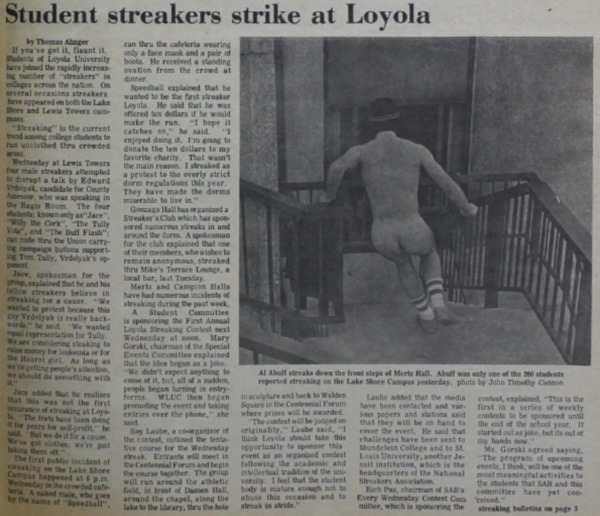
This article by Thomas Ahnger discusses the streaking phenomenon at Loyola. Featuring a shot from behind of student who named himself as Al Abuff streaking "down the front steps of Mertz Hall" wearing only a hat, striped socks, and shoes, and said to be one of 200 students streaking on the Lake Shore Campus the day before.
The article discusses four students who "streak for a cause" by disrupting a talk by County Assessor candidate Edward Vrdolyak and holding pins for his opponent, a student who streaked on Wednesday through the cafeteria for $10, a streaker's club at Gonzaga Hall "sponsoring" streaking events, and a joke for a streaking contest that got out of hand and was becoming an officially sponsored race around the Lake Shore Campus.
-
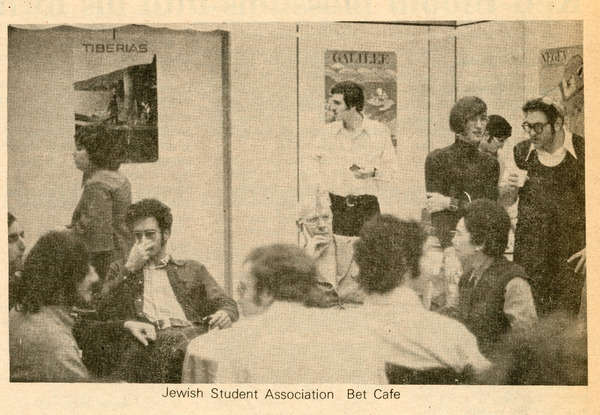
This picture accompanied an article by Pat Murphy discussing the Loyola Jewish Students Organization becoming recognized by the Loyola Student Government Organization. According to the new organization's chairman, Dave Magence, the goal ws "to foster Jewish unity" and "provide both intellectual and social stimulation for the group," as well as to be a resource for mutual aid in times of need. Their first event was on Feb. 9, clled a "Bet Kaffee," a type of coffee house, and they planned an upcoming celebration of Purim. A photo shows members and attendees at the Bet Kaffee. The article also discusses the possibility of Judaic Studies courses. This was likely the first official non-Catholic religious student group at Loyola, and represented a new ecumenical approach by Campus Ministry.
-

A cut-and-paste collage of words and images related to current events and student life in the 1969-1970 school year.
-
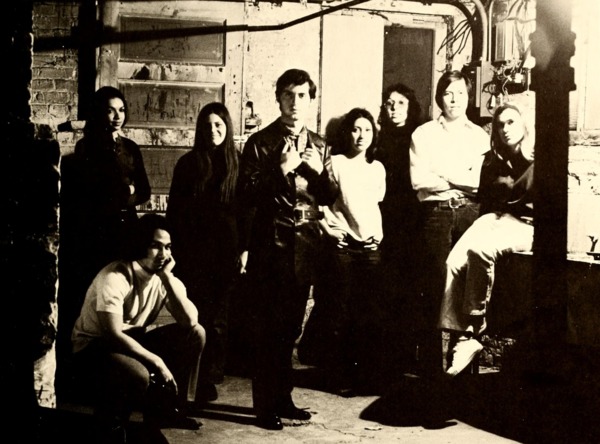
Members of the Latin American Student Organization at Loyola pose in a room with exposed pipes and brick walls.
The description explains:
"The Latin American Student Organization has been in existence for five and one half semesters. Its accomplishments have been numerous and beneficial to the Latinos here at Loyola and throughout the burrios of Chicago.
Ever since its founding, the organization's guiding ideology has been one of progressive change in order to serve the Latino community relevantly."
Members in this photo and the photo on the facing page:
"Migdalia Garlarza, Dru Gallagher, Felipe Aquirre, Dino DiMartino, Nella Ferrara, Milica Govedarica, Maria Gritz, Vicky Vallejo, Deborah Washington, Ed Torres, Art Rimando, Jose Vargas, Henery Cisneros, Al Cisneros, Alice Diaz, Carlos J. Salazar (President), Denise Hutson, Kathy Somos, Carol Mikos, Carmen Cintron, Elia Lopez, Rosalie Sanchez, Mirrya Guerrero, Glady Saavedra, Alfonso Perez, Maria Diaz, Lucy Perez, Gerry Bjurman, Juan Garza, Carmen Franco, Emelia Rosada."
-
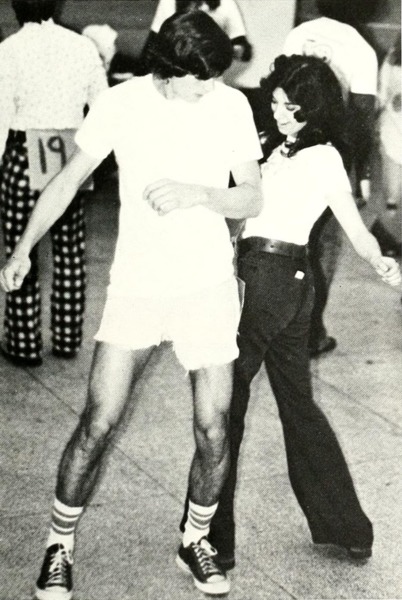
A pair of dancers at the 1975 Dance Marathon do the Bump by hitting opposite hips. The Dance Marathon raised almost $8,000 for Muscular Dystrophy.
-

(left) The first page of the May 17, 1970 issue of The Skypaper.
(right) The cover page of the November 20, 1970 issue of Take Issue.
This collage was created using images from various sources (see 'Source' for more information).
-
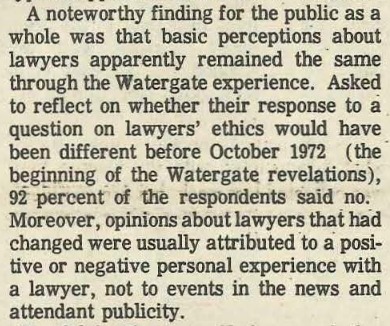
Blackacre, the Loyola School of Law's student newspaper, noted an important finding from the American Bar Association's national survey which found "basic perceptions about lawyers apparently remained the same through the Watergate experience." [image cropped]
-

A cropped image shows Jane Byrne standing at a podium with a microphone in her hand, speaking in a room with tall curtains. Behind her, at a long table, sit several guests with name tags, who smile and face the same direction as Byrne.
-

Jane Byrne stands at a podium with a microphone in her hand, speaking in a room with tall curtains. Behind her, at a long table, sit several guests with name tags, who smile and face the same direction as Byrne.
-

Mundelein students holding signs protest against the Vietnam War. Most of the students are lined up in a row, with another student holding a guitar standing to the side. The first student in the row holds a sign with the words "They shoot students, don't they?".
-

Reverend Jesse Jackson stands at a podium on a stage with several microphones in front of him during an event for Operation Breadbasket.
Behind him are placards spelling the word "Anniversary" and in front of the stage is a Christmas tree cutout with several pasted paper baubles containing the names of various products.
According to page 3 of the 1966, June 1 issue of the student newspaper Skyscraper, Operation Breadbasket was a "grassroots organization planning a boycott of 300 food stores for discriminatory hiring policies at all levels." The operation's activities also included a series of marches against real estate practices in Chicago suburbs.
-
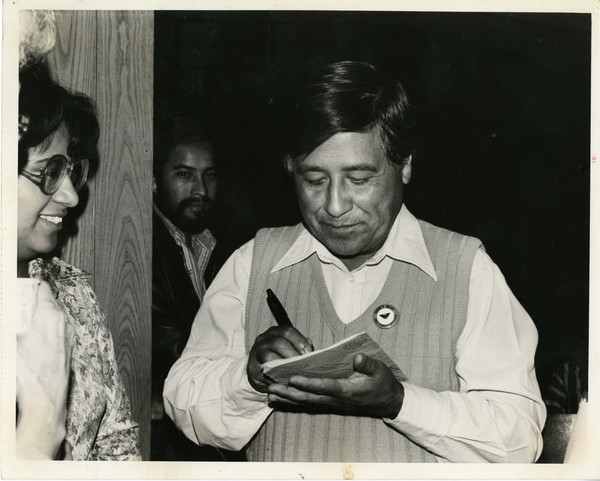
Cesar Chavez, dressed in a vest and collared shirt, writes in a booklet as two unidentified individuals look on. There is a pin badge on Chavez's vest with the words "Don't Buy Red Coach Lettuce" encircling a symbol of an eagle.
Cesar Chavez visited Mundelein College in November 1979. His talk was part of a bilingual Eucharist to commemorate the 50th anniversary of the groundbreaking of the Skyscraper. Chavez was part of the California lettuce strike which sought to improve working conditions for migrant farm workers.
-
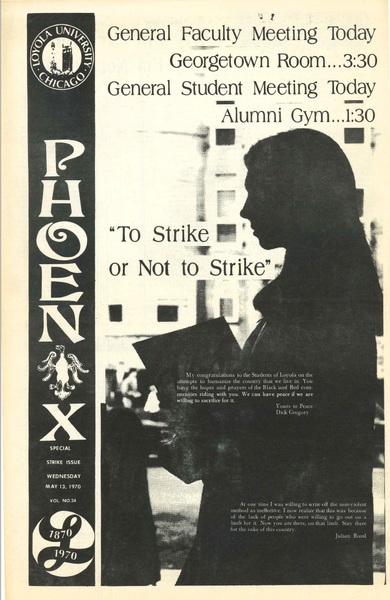
This cover page of the special Loyola Phoenix May 13, 1970 strike issue features the silhouetted profile of a student holding a folder/book in their hands. To the left of the profile, there are the words "To Strike or Not to Strike"; quotes from Dick Gregory and Julian Bond are also present on the page. The Skyscraper can be seen in the background.
-

The Loyola Phoenix produced a special edition to cover the ongoing sit-ins and legal action taken by law students, who were frustrated by the law library's non-compliance with standards set by the Association of American Law Schools.
To accommodate their demands, Loyola built Maguire Hall, their new law school building.
























